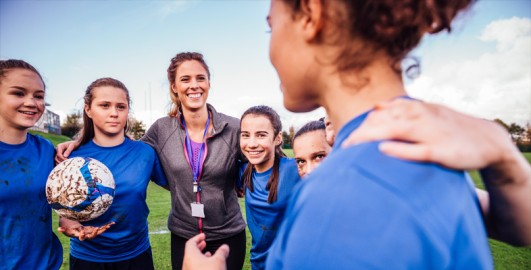2 Experiencing diverse sporting spaces
Athletes taking part in sport and exercise experience a range of environments as part of their preparation, training and competitions. This shift between different environments, or ‘spaces’, can therefore be experienced differently from athlete to athlete. With an individualised approach to neurodiversity in mind, we can explore how one athlete could experience these changes, in contrast to what a neurotypical teammate or training partner may experience as normal or easy to navigate. The following activity will help you do this by focusing on potential issues posed by different sporting spaces.
Activity 2
Part 1
Watch the clip below of Sam Holness, talking about his experiences training and competing in Ironman and triathlon events (the interviewer, Nick Ransom is also neurodivergent). While watching, make two lists, one of the positive things Sam says he gets from being a triathlete, and one of the negative things. You may want to watch the clip twice to help you.
Neurodiversity in Sport. Watch from 2:03 to 2:59.
Discussion
You may have picked up on how Sam describes the positives of competing and how this helps him feel better about himself and improves his feelings of anxiety. This demonstrates the links previously discussed between neurodiversity and wellbeing. You may also have noted how Sam describes feeling overwhelmed when there are too many other athletes around him, as well as worries about not only being autistic, but also how he is often the only Black athlete. This links strongly with the concept of intersectionality introduced in Week 1.
Part 2
The table below lists a range of potential challenges faced by neurodivergent athletes. For each one, complete the right-hand column with issues that you think an athlete like Sam may experience as part of their training and competition routine. These issues could be sensory, or to do with communicating and interacting with others. Try to hold in mind an individualised approach as you work through each challenge. When you have completed the table, you can compare your answers with those in the Discussion.
| Challenge | Potential sensory or communication issues |
| Changing room area | |
| Surrounding area (transport links, car park) | |
| People | |
| Indoor facility | |
| Outdoor facility | |
| Equipment | |
| Coach |
Comment
| Challenge | Suggested sensory or communication issues |
| Changing room area |
|
| Surrounding area (transport links, car park) | Unpredictability of:
|
| People |
|
| Indoor facility |
|
| Outdoor facility |
|
| Equipment |
|
| Coach |
|
This activity will have prompted you to think about how different sporting spaces can be experienced by neurodivergent athletes. You may have come up with similar issues to the ones suggested in the final column, or you may have thought of some different ones too. As a coach, planning for these issues is what McMurtry et al. (2025) describe as part of the process of implementing ‘reasonable adjustments’ to support athletes, remembering that no two athletes will experience these spaces in the same way. This reinforces the importance to really focus on the practice of talking to athletes and asking them what they may need to make these experiences less difficult or overwhelming. By doing this, coaches can make sporting spaces more accessible, supportive, and ultimately promote positive wellbeing in those they are coaching.
The individualised experiences of neurodivergent people can mean things which are a protective factor for some, can cause difficulties for others. For example, one athlete may find the structured way that athletes and coaches interact with each other as something which helps them. Conversely, an athlete in the same session may find those structured interactions too rigid and overwhelming. This should not mean that both athletes are unable to take part in the same session. Instead the coach can explore what those individual needs are and what reasonable adjustments they can make to their coaching practice to ensure that both needs are being met. The next section helps you explore a key factor which makes this approach difficult – when athletes often ‘mask’ their neurodivergent experiences.
